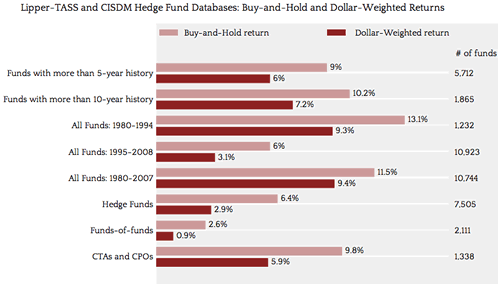When a mutual fund or hedge fund lists their historical returns, the industry standard is to use time-weighted returns that assume you buy at the beginning of the time period and hold until the end. However, what often happens is that a fund will start out small and have great returns for a while, gradually start attracting lots of investor money, and then the subsequent returns are not so hot. Whatever special inefficiency or investment idea the fund managers had initially is either wiped out by market forces over time or simply hindered by asset bloat. In such a case, the actual returns experienced by investors is less than what is listed under fund return data, even though things like 5-year trailing returns still look quite good.
Via Abnormal Returns, Ben Lorica of The Verisi Data Studio took an academic paper by Dichev and Yu [pdf] in the Journal of Financial Economics and made a nice visualization of the hunk of data presented about hedge funds:
From the paper’s conclusions:
Using a comprehensive sample, the main finding is that dollar-weighted investor returns are about 3% to 7% lower than fund returns, depending on specification and time period examined. This difference is economically large, and it is enough to reverse the conclusions of existing studies which show outperformance in hedge fund returns. In addition, the estimated dollar-weighted returns are rather modest in absolute magnitude; for example, they are reliably lower than the returns of broad-based indexes like the S&P 500 and only marginally higher than risk-free rates of return.
Most of us can’t invest in hedge funds even if we wanted to, so this is best taken as a larger lesson to be careful when chasing hot returns by any money manager. You don’t want to be the last money in. Morningstar also tracks “investor returns” (dollar-weighted) separately from “total returns” (traditional, time-weighted) in their mutual fund listings.

 The Best Credit Card Bonus Offers – 2025
The Best Credit Card Bonus Offers – 2025 Big List of Free Stocks from Brokerage Apps
Big List of Free Stocks from Brokerage Apps Best Interest Rates on Cash - 2025
Best Interest Rates on Cash - 2025 Free Credit Scores x 3 + Free Credit Monitoring
Free Credit Scores x 3 + Free Credit Monitoring Best No Fee 0% APR Balance Transfer Offers
Best No Fee 0% APR Balance Transfer Offers Little-Known Cellular Data Plans That Can Save Big Money
Little-Known Cellular Data Plans That Can Save Big Money How To Haggle Your Cable or Direct TV Bill
How To Haggle Your Cable or Direct TV Bill Big List of Free Consumer Data Reports (Credit, Rent, Work)
Big List of Free Consumer Data Reports (Credit, Rent, Work)
Install the dropbox app on your iphone/ipod touch and you can have access to your dropbox files on your mobile device. Also, it allows you to download files locally (by marking as “favorite”) to you mobile device. Most common files can be opened by the ipod/iphone.
On a side note, I have had one annoying issue with the dropbox program on my PC. If I try to do something else on the internet while the program is syncing, it freezes my internet traffic for exactly 3 minutes. Does anyone know how to fix this? Thanks.
Please delete my comment above. I meant to post it on the dropbox post.
Hedge fund industry is now mature, with too much money chasing to few investments.
Once profitable strategies are now useless because of so many competitor.
Money has been invested thanks to the development of fund of fund and ETFs.
Right now, even an individual investor can invest in a hedge fund strategies thanks to active ETFs.
This is far often the case not just in hedge funds but in premium stock picking newsletters or insiders guides. Investors are very selective with the picks cause most fail or do not perform as expected. They also use different metrics and different periods of time to calculate them. These may or may not be 100% accurate, but they are certainly not the most truthful.
Don’t mutual funds report the same exact way?